Raw and boiled potatoes as feed for guinea pigs, hamsters and livestock
Pet lovers try to diversify the diet of their pets. However, it happens that such care leads to sad consequences. Small domestic rodents are at high risk of food poisoning. Often children try to feed them what they eat themselves. Adults love to experiment too - and not always successfully.
Potatoes are considered a popular and affordable animal feed. In raw and boiled form, it is widely used in animal husbandry. Many guinea pigs and hamsters love any kind of vegetable. But it is not suitable for everyone due to the physiological characteristics of the body.
The content of the article
Chemical composition, trace elements and characteristics of potatoes
Potato - annual tuberous plant, food and agricultural crop... Serves as raw material for the food, chemical, textile industries.
Depending on the nutritional composition of the tubers, the vegetable is divided into groups:
- dining room;
- stern;
- technical;
- universal.
100 g of product contains 17.5 g of carbohydrates... This represents about 89% of all energy from a serving.
Calorie content - 77 kcal.
Basic composition in 100 g:
- fats - 0.09 g;
- proteins - 2.05 g;
- carbohydrates - 17.49 g;
- water - 79.25 g;
- ash - 1.11 g.
The root vegetable contains fat-soluble vitamins - beta-carotene, B and K. Water-soluble vitamins are represented by vitamins C, B1, B2, B3 (PP), B4, B5, B6 and B9.
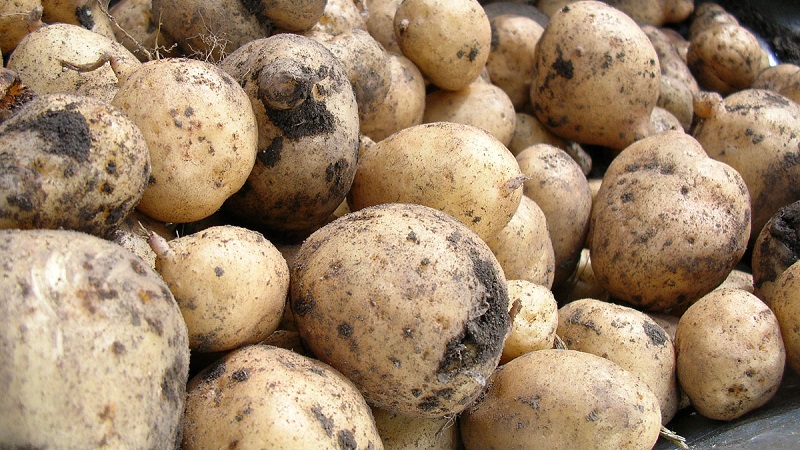
As part of raw potatoes:
- calcium;
- iron;
- magnesium;
- phosphorus;
- potassium;
- sodium;
- zinc;
- copper;
- manganese;
- selenium.
How good are potatoes for animal feed?
Forage varieties are widely used in animal husbandry... But not all animals digest this product well.
Leaders in potato consumption among livestock - pigs... Their body assimilates 90% of the protein contained in the tubers. However, we are not talking about raw, but about boiled potatoes. On pig farms, boiled tubers are pounded and mixed feed is added to them in a 4: 1 ratio. With this diet, pigs gain weight well.
Cattle are unpretentious and eat raw potatoes... The chopped vegetable is mixed with grain or silage. Artiodactyls eat not only tubers, but also the tops, the peel left over after peeling.
A relatively new type of feed - dried potatoes, approved by livestock breeders... It is nutritious due to its high protein and feed units. It weighs 5 times less than raw feed, therefore it is popular for preparing feed mixtures. The dried product is easier to store - it takes up less space and has a long shelf life.
Can guinea pigs be given potatoes
Fans of decorative pets are trying to diversify the diet of their pets.
When deciding to feed a guinea pig with potatoes, the composition of the product is studied. Experienced owners are alarmed by the large amount of starch in a vegetable. Therefore, complementary foods begin with small doses.
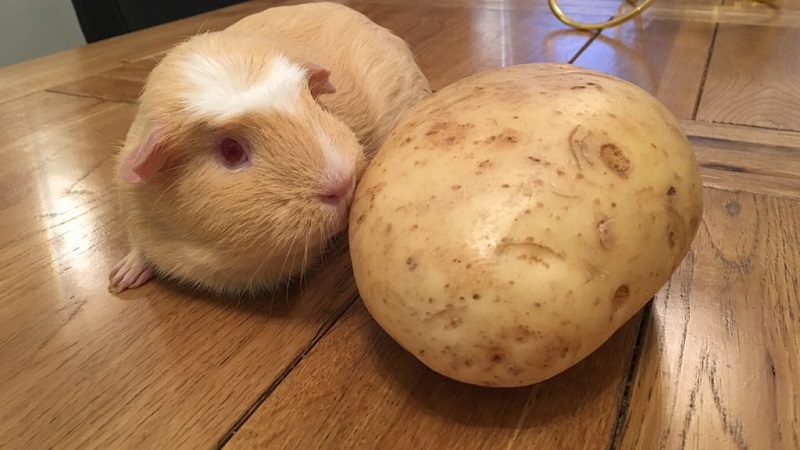
Raw
Can guinea pigs eat raw potatoes? The animal owners check this on their own. A small piece of raw tuber is placed along with other familiar vegetables... Observe the reaction to the new product. Even if the animal ate it with pleasure, it is not recommended to immediately give the second piece. Monitor the reaction of the body during the first day.
The next 3 days also give one piece at a time, preferably before lunch, to notice possible deviations in digestion. If the pet is feeling well, then raw potatoes are included in his diet 2-3 times a week.
Boiled
Veterinarians recommend giving boiled tubers to elderly guinea pigs... Aging individuals find it difficult to chew on raw potatoes.
Boiled potatoes are kneaded with a fork and added to the feed. It is better digested and replenishes the aging body with vitality.
Read also:
Is it possible to give rye to rabbits, chickens, pigs and cows
Can hamsters give potatoes
Veterinarians and pet specialists have conflicting opinions on whether hamsters should be given potatoes.... It all depends on the individual physiological characteristics of each animal.
With good tolerance, the absence of disorders of the digestive system, signs of deterioration in well-being, the vegetable is included in the rodent's diet in small quantities.
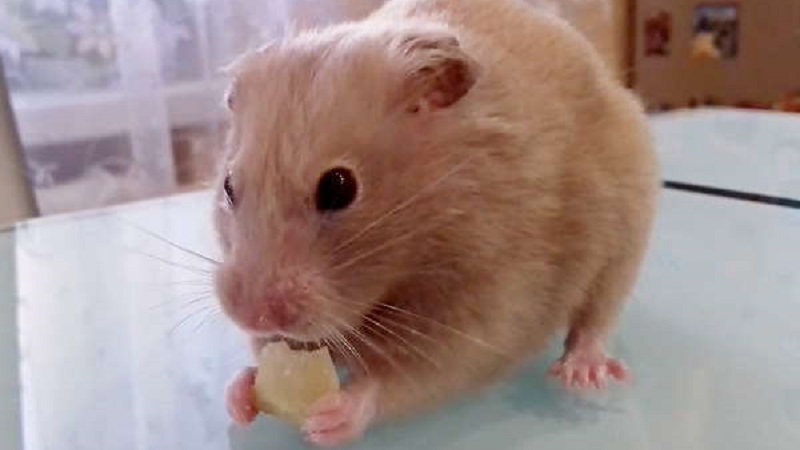
Raw
The hamster, as a representative of rodents, eats raw vegetables and fruits in nature... A pet is no exception, so hamsters will benefit from raw potatoes.
With a lack of vitamin C, the vegetable helps to fight vitamin deficiency, and fast-growing teeth are better grinded against raw tubers.
Boiled
It is recommended to include boiled vegetables in the hamster diet. They easier to digest, especially by older individuals.
Attention! The vegetable is boiled without salt.
Boiled vegetables are high in starch, which leads to weight gain. An excess of mass badly affects the work of the heart in rodents, the general well-being worsens. Therefore, such a product should not be given daily.
Features of fodder potatoes for livestock
Potatoes that are grown for livestock feed are called fodder. These varieties have a higher amount of protein, but have a less pronounced taste.... It has a beneficial effect on the body of animals and increases their productivity.
Forage culture is distinguished:
- high productivity;
- high content of nutrients;
- short ripening times.
Fodder tubers are usually 2-3 times larger than table tubers... They are often irregular in shape and taste bland and watery. Strongly boiled during cooking.
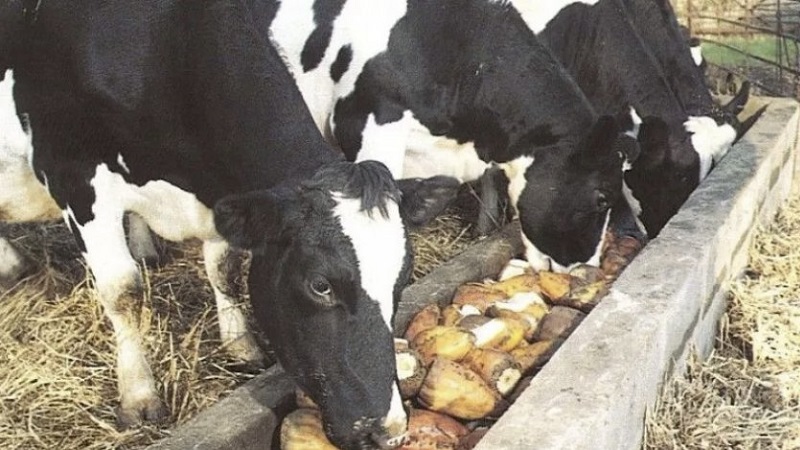
Benefits of feed tubers:
- high starch content - it is well absorbed;
- high amount of protein - animals grow quickly;
- a complete set of nutrients - other crops grown for feed do not have this nutritional value;
- high yield rates.
disadvantages:
- with prolonged storage, useful properties decrease;
- if the storage conditions are not observed, they turn green, and a poisonous substance - solanine is formed in them.
Silage technology is used for long-term storage - tubers are acidified with organic acids, which are formed during the fermentation of sugars.
Potato harm
In case of high content in tubers solanine there is a risk of animal intoxication.
The severity of the poisoning depends on the amount of potatoes eaten, from the physiological characteristics of animals.
For guinea pigs
Veterinarians consider the main disadvantage of potatoes a large amount of starch.
If the pet has a healthy digestive system and after complementary feeding it feels good, the diet includes a raw vegetable, in small quantities and infrequently.
When there is an excess, there are consequences:
- obesity;
- enlarged liver;
- chronic diarrhea;
- hepatitis.
For hamsters
Categorically it is forbidden to give raw potatoes to Dzungarian hamsters.
The digestive system of this rodent is especially sensitive. A small amount of solanine in the product will cause intoxication.
Boiled potatoes are recommended for Dzungarian hamsters in moderation in combination with other feeds.
For livestock
For feed to farm animals use vegetable tops and tubers.
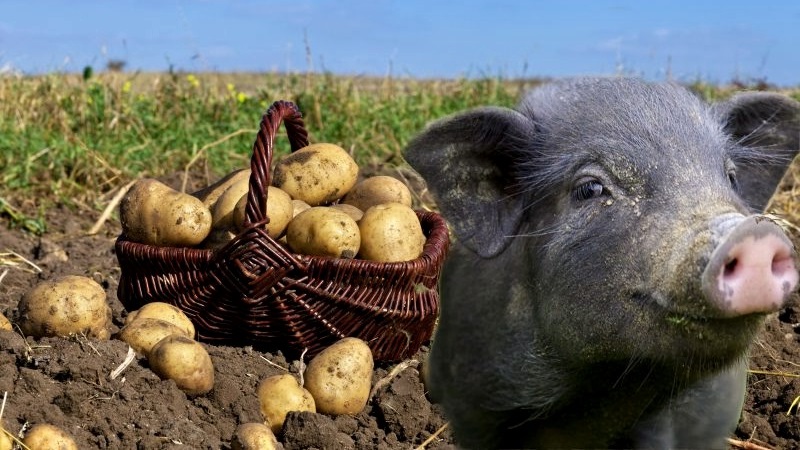
Small amounts of solanine are found in potato tops and young potatoes... Its content increases with prolonged and improper storage.
Tubers that have been in the sun for a long time pose a great danger to livestock. Animals that graze in these fields after harvesting potatoes are at great risk of poisoning.
Important! Even water in which the peel with sprouts or green tubers have been boiled is dangerous. It is strictly forbidden to give animals to drink with such a decoction.
Conclusion
In animal husbandry, fodder potato varieties are used. They are distinguished by their nutritional value, high yield, and high protein content. The animals are fed raw and boiled vegetables. As a complementary food, ordinary table potatoes are given to hamsters and guinea pigs.
For young individuals, a raw, high-quality product in small doses is not harmful. Abuse leads to excess weight, digestive system upset. It is strictly forbidden to give raw tubers to the Dzungarian hamster because of the sensitive digestive system.
For all animals, the greatest danger lies in green and sprouted tubers. Poisonous substance - solanine - causes intoxication of the body, small rodents die even at low doses.